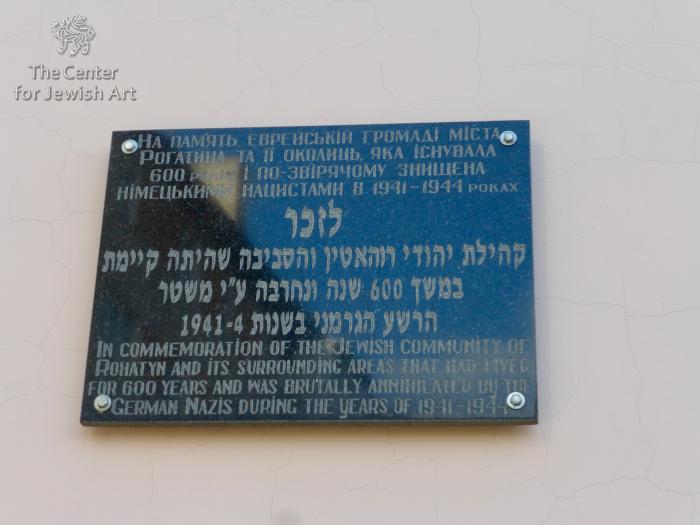Obj. ID: 49865
Jewish Funerary Art Memorial Plaque to the Jewish community in Rohatyn, Ukraine
To the main object: Synagogue at 3 Kotsiubynskoho St. in Rohatyn (Rogatin), Ukraine

Official name
Меморіальна дошка на пам'ять про винищення єврейської громади м. Рогатина
Translation: Memorial Plaque to the Memory of Extermination of Jewish Community of the city of Rohatyn
Who is Commemorated?
Jewish Holocaust Victims from the Rohatyn district and the surrounding areas Description. This memorial plaque is located on a former Judenrat building in Rohatyn on the side that faces Kotsiubynskoho Street. It is a black stone rectangular plaque, which bears inscriptions in Ukrainian, Hebrew, and English.
Inscriptions
Ukrainian:
На памʼять єврейській громаді міста
Рогатина та її околиць, яка існувала
600 років і по-звірячому знищена
німецькими нацистами в 1941–1944 роках
Translation: To the memory of the Jewish community of the city of Rohatyn and its surroundings, which existed for 600 years and was brutally exterminated by the German nazis in 1941–1944
Hebrew:
לזכר
קהילת יהודי רוהאטין והסביבה שהיתה קיימת
במשך 600 שנה ונחרבה ע"י [=על ידי] משטר
1941-4 הרשע הגרמני בשנות
Translation: To the memory of the Jewish Community of Rohatyn and surroundings, which existed for 600 years and was ruined by the German evil regime in 1941–4
English:
In commemoration of the Jewish community of
Rohatyn and its surrounding areas that had lived
for 600 years and was brutally annihilated by the
German Nazis during the years of 1941–1944
Commissioned by
[Possibly] Rohatyn Jewish Holocaust survivors and their descendants
sub-set tree:
In 1939, there were 9,685 Jews in the Rohatyn district, and 3,250 Jews in the city of Rohatyn itself [Solovka, p. 550].
The German Army occupied Rohatyn on July 5, 1941 [Solovka, p. 187]. The first large Action in the city took place on March 20, 1942, when 1,820 Jews were shot. During the second mass murder on September 21-22, 1942, about 300 Jews were killed in the city, and 700 people were deported to the Bełżec killing center. In October 1942, Jews from Bursztyn, Bolszowce, and Bukaczowce were deported to Rohatyn. On December 8, 1942, nazis deported from Rohatyn about 1,400 Jews and killed about 500 Jews in Rohatyn. From February to April 1943, several Actions took place in Rohatyn [Encyclopedia]. In total, between 5,000 and 9,800 Jews perished in Rohatyn [Solovka, p. 550].
Most gravestones from the Old and New Jewish Cemeteries were demolished during the German occupation of Rohatyn. The headstones were used in construction and paving streets [Jewish grave markers]
The Holocaust memorialization process in Rohatyn began in the 1980s, when the Soviet authority installed two square slabs near the North and the South mass graves. These monuments only marked the killing sites and approximate locations of mass graves, their short inscriptions did not give any information about the events and the victims [Rohatyn’s Shoah Killing Sites].
In 1998, Rohatyn Jewish survivors erected two new monuments near the North and the South mass graves. This memorial plaque on the former Great synagogue and former Judenrat building was also installed about that time [Rohatyn’s Shoah Killing Sites]. In the 1990s, Jewish survivors and their descendants also installed Holocaust monuments in the New Jewish Cemetery and the Old Jewish Cemetery in Rohatyn [Jewish cemeteries of Rohatyn]. All these monuments bear inscriptions in Ukrainian, English, and Hebrew.
Since the 1990s, local Ukrainian activists, Jewish survivors, and their descendants returned gravestones from around the city to the Jewish cemeteries. In 2011, members of the Rohatyn Jewish Heritage NGO joined this process, accelerating it. Together with local residents, they currently maintain, investigate the territories of the cemeteries, and work on further memorialization [Jewish grave markers].
Among all the Holocaust monuments in Rohatyn, only the memorial plaque on the former Great synagogue and former Judenrat building was included in the List of Monuments of History and Monumental Art of Local Significance in the Ivano-Frankivsk Region as of 2023.
The "Rohatyn Jewish Heritage" NGO organizes annual commemorations of the days of mass murders; on March 20 near the Second Monument on the South Mass Grave, and in June near the Second Monument on the North Mass Grave. During these events, activists read the prayer El Malei Rachamim (“God full of mercy”). The activists of the "Rohatyn Jewish Heritage" NGO also maintain the Second Holocaust Memorial on the North Mass Grave and the Second Holocaust Memorial on the South Mass Grave and plant flowers around them. The Soviet monuments on the North and the South mass graves are not involved in commemoration activities [Rohatyn’s Shoah Killing Sites].
Encyclopedia of Camps and Ghettos 1933-1945, ed. Martin Dean, vol. 2 (Bloomington: The United States Holocaust Memorial Museum, 2012), pp. 821–822.
"Jewish Cemeteries of Rohatyn," Rohatyn Jewish Heritage, https://rohatynjewishheritage.org/en/heritage/cemeteries/ (accessed June 15, 2023)
"Jewish Grave Markers, Lost and Recovered," Rohatyn Jewish Heritage, https://rohatynjewishheritage.org/en/heritage/headstones/ (accessed June 15, 2023)
"Rohatyn’s Shoah Killing Sites and Mass Graves," Rohatyn Jewish Heritage, https://rohatynjewishheritage.org/en/heritage/mass-graves/ (accessed June 6, 2023)
Solovka, Liubov and Svitlana Oryshko, 150 iz 150 tysiach... Holokost yevreiv Prykarpattia yak skladova etnodemohrafichnoi Katastrofy Skhidnoi Halychyny, (Ivano-Frankivsk: Foliant, 2019), p. 550.



